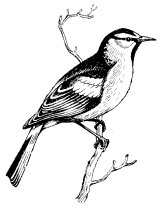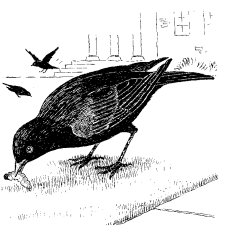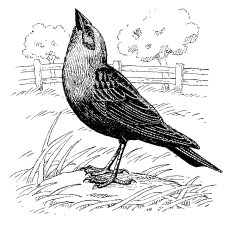
WESTERN MEADOWLARK
| Online Library: | Title | Author | California | Geology | History | Indians | Muir | Mountaineering | Nature | Management |
Yosemite > Library > Birds of Yosemite > Orioles & Blackbirds >
Next: Tanagers • Contents • Previous: Weaver Finches
YELLOW - HEADED BLACKBIRD (Xanthocephalus xanthocephalus): 8-11 in. Head, neck, and breast yellow; rest of plumage black except large white patch on black wing. Female: Smaller than male; grayish-brown, faintly streaked below; throat, upper chest, and line over eye yellowish; no wing-patch. Frequents tule marshes and adjacent meadows or cultivated ground chiefly in the Lower Sonoran to the Transition life zone. C. V. to the Yosemite region. Has been recorded occasionally in Yosemite Valley.

WESTERN MEADOWLARK |
R. in open grasslands, breeding in the Lower Sonoran to the Transition life zone. Seen in the San Joaquin Valley into the Sierran foothills. In the Yosemite region after the breeding season may be found to high altitudes as on top of Half Dome and near Ten Lakes, 9,700 feet. Occasionally seen in Yosemite Valley.

REDWINGED BLACKBIRD |
Frequents marshes, moist fields, and margins of ponds, lakes, and slowly flowing streams where grown to tules, sedges, and willows. Inhabits the Lower Sonoran to the Transition life zone during the breeding season. Found locally in the Yosemite region below the Canadian life zone. Common in open wet meadows of Yosemite Valley in spring and early summer, where they nest, the males to be seen conspicuously guarding the nests.

BULLOCK’S ORIOLE |
Frequents streamside and oak woodland in the Lower Sonoran to the Transition life zone. Common S. V. at lower elevations on the west side of the Sierra. C. V. to Yosemite Valley.

BREWER’S BLACKBIRD |
Frequents grasslands meadows, stream and lake borders, lawns, and cultivated fields, usually where there are scattered trees for roosting and nesting. Inhabits the Lower Sonoran to the Canadian life zone. In the Yosemite region nests as high as the floor of Yosemite Valley and in summer and fall ranges upward nearly to timberline. Migrates to lowlands in winter. One of the most abundant birds in Yosemite Valley in spring and summer.

BROWN-HEADED COWBIRD |
Frequents lowlands where meadows and pastures are situated near tracts of willows and cottonwoods. Inhabits chiefly the Lower and Upper Sonoran life zones but occasionally enters the Transition zone. C. V. to the Yosemite region. Commonly seen in Yosemite Valley.
Next: Tanagers • Contents • Previous: Weaver Finches
| Online Library: | Title | Author | California | Geology | History | Indians | Muir | Mountaineering | Nature | Management |
http://www.yosemite.ca.us/library/birds_of_yosemite/orioles_blackbirds.html